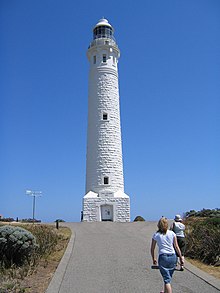Cape Leeuwin
- 34.376391666667115.13495555556Koordinaten: 34 ° 22 '35 " S, 115 ° 8' 6" O
Cape Leeuwin, Cape Leeuwin English, (debate ' luwɪn listen? / I ) is the most south-westerly point of mainland Australia. It is located in the state of Western Australia, about seven kilometers south-southwest of Augusta and about 180 km south-southwest of Perth. The name of the cape probably comes from the Dutch word leeuwin for " Lioness " (see story).
Although Cape Leeuwin the southernmost point of Australia is not ( cf. South Point and the southeast ), it applies to the Cape of Good Hope and Cape Horn, one of the three "big" Cape of southern hemisphere and symbolic waypoint for reaching or passing of Australia for Deep-sea shipping to or from the open Indian Ocean.
Location
Cape Leeuwin is the southern headland on an anvil- shaped peninsula, the northern tip of the Cape Naturaliste (formerly partly Naturforscherkap ) is. The peninsula is in tourist brochures according to the two capes as Cape to Cape called (from the Cape to Cape ) or the Capes ( the Cape ). Since 2001 there is also a 135 km long trail between the two capes, called the Cape to Cape Track, which runs from the lighthouse at Cape Leeuwin to the lighthouse at Cape Naturaliste. On the peninsula lies the Leeuwin - Naturaliste National Park, one of the most visited national parks in Australia.
To the east, joins the Cape Leeuwin after Matthew Flinders named Flinders Bay ( Flinders Bay) where the north coast of Augusta, the cape nearest settlement is located. To the southeast of the bay is bordered by the D' Entrecasteaux Point.
Cape Leeuwin is portrayed partly as a limit point of the Indian and Southern Ocean ( Antarctic Ocean ), for example, a person standing on Cape billboard (see picture right). In general, the name Southern Ocean, however, used only for the waters south of the 60th parallel - about 2850 km further south as Cape Leeuwin. Accordingly, it usually includes the sea in the south of Australia - west of Südostkaps in Tasmania - calculated to the Indian Ocean (see, for example, on the map of the CIA World Factbook, top right).
History
The cape was called on early Dutch maps around 1622 as t landte Leeuwin. This suggests that the Cape by the Dutch ship De Leeuwin ( hook size for " the lioness " ) was sighted from. In the following years it was seen by many Dutch, French and English explorers. These were:
1830, the area was settled around the Cape.
The Cape Leeuwin Lighthouse
The Cape Leeuwin Lighthouse (Cape Leeuwin Lighthouse ) and it surrounding buildings were built from 1895 to 1896 in native limestone. 1895 Tower of the Australian explorer and politician John Forrest was inaugurated, the fire was first lit on December 1, 1896.
Originally a second, smaller, red tower was planned before the 39 -meter-high white tower. The base of the tower was laid, but the construction does not resume, as it was now feared a second light will only confuse the shipping and lure ships closer to the coast.
The light source of the lighthouse fire was originally a kerosene wick lamp, then the world's largest rotating in a mercury bath lamp. 1925 was converted to oil vapor and 1982 on electricity. In 1992, the operation was automated. The lighthouse has an identifier of a flash in 7.5 seconds. His fire, installed at a height of 56 meters ( above sea level) has, at a light intensity of a million Candelas (CD) has a range of 25 nautical miles ( approximately 46 kilometers ).
The lighthouse serves not only as a navigation mark, but is also an important - now also automated - weather station. In the 1960s, a telecommunications tower, the plant was built in the northwest of the lighthouse, in the 1980s expanded to two telecommunications towers. Meanwhile, the telecommunication towers were demolished again.
The lighthouse has seven floors and 186 steps. In recent years, the temporarily beige tower has been re- painted white. The lighthouse and its surrounding area are accessible for inspections.










